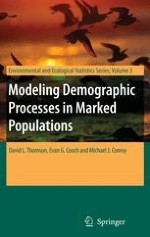Abstract
Delayed recruitment (i.e. first reproduction) is a key feature of the demography of long-lived species such as seabirds. If physiological, behavioral, and environmental factors are thought to influence age at first breeding, knowledge of the fitness prospects corresponding to different recruitment tactics is needed to get insight into the evolution of delayed recruitment.
Because the age at which an individual recruits may depend on the location chosen to breed, we first investigated the relationship between habitat quality and age of first breeding in a long-lived seabird, the black-legged the Kittiwake (Rissa tridactyla). We used multi-state mark-recapture approaches to model the transition from non-breeding to breeding status as a function of age and habitat quality. We also investigated whether there was a relationship between age at recruitment and reproductive success in the year of recruitment. We assessed several non-exclusive hypotheses. (i) If experience plays a part in reproductive success per se (e.g. in the quality of parental care), or in acquisition of higher-quality breeding sites (i.e. increased competitive ability), then reproductive success should be lower for early recruits (i.e. age 3) than others. (ii) In the same vein, if delayed recruitment corresponds to a queuing tactic allowing access to higher-quality sites, then late recruits (age 6 or 7) should exhibit higher breeding success than others. Alternatively, delayed recruitment may reflect behavioral inability to access to higher-quality sites; in this case, late recruits should exhibit poorer breeding success than younger ones. (iii) Experience combined with social constraints may lead to an initial increase in breeding success with recruitment age, and a decrease in older recruits.
We found that recruitment probability was highest at intermediate ages (i.e. 5–6 years old), and that recruitment probability was maximal in habitat patches (i.e. ‘cliffs’) of medium quality. This may reflect harsh competition in the most productive cliffs, and avoidance of the least productive ones (i.e. where predation on eggs is high). In accordance with our predictions (i and iii), we found that the youngest recruits experienced poor breeding success at the beginning of their reproductive life, and that breeding success was higher for birds recruiting at intermediate age. In addition, recruitment probability was best predicted by apparent habitat quality the year preceding recruitment. The latter result suggests either that habitat selection takes place the year preceding settlement and first reproduction, or that the information available to individuals at the beginning of a season is temporally auto-correlated to past productivity.
Reproductive choices and/or the constraints met during the pre-reproductive stage of life may influence age at recruitment. Our results show that there is a relationship between age of first breeding and breeding success probability. However, age of first breeding may also have substantial effects on breeding success over life. Future study should examine if reproductive success improves, shows senescent decline, or remains the same over the life course of individuals recruiting at various ages.
